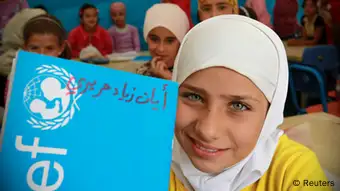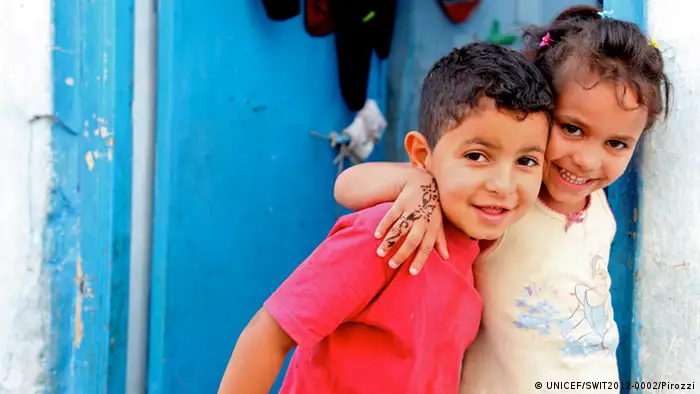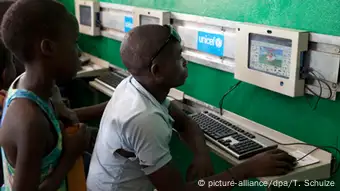Insights
How technology can help educate child refugees
Designing with users, building on existing ideas and understanding the ecosystem are some of the prerequisites for success when creating digital projects in education argues Becky Telford from UNICEF.
Around 30 million children worldwide are denied education because of conflict. Many have fled war and have no, or limited, access to education. Others live in areas where it's too dangerous to attend school or where conflict has ravaged infrastructure.
Digital technologies are seen as one way of helping meet the challenge of getting education to children displaced by conflict. #mediadev talks to Becky Telford, the Global Innovation Product Content Strategist at UNICEF's Global Innovation Center about the possibilities and pitfalls of using digital technology to educate child refugees.
#mediadev: How do you think digital technologies could contribute to overcoming the challenges of making education accessible to refugees?
Becky Telford: A key benefit is that digital approaches to education can provide access in places where access wouldn't otherwise be possible. In Jordan, for example, you have double-shift schools because of the refugee crisis. There is a huge number of children in the classroom with very little additional resources. Being able to put things together digitally would mean ... you can provide resources like textbooks and teacher tools very quickly, as well as resources that children can use as enrichment. In such a crowded context that would mean a teacher can teach half the class really effectively and the other half of the class can use guided digital materials.
Would you say that access to education is the most important thing that digital technologies can provide?

Girl at school in Al Zaatri refugee camp, Jordan: A successful digital project has to be driven by user need
It is one of the main needs but definitely not the only one. Aside from access, there are great projects ... using digital resources to integrate things like psychosocial support and life skills into educational resources to meet some of the additional needs refugees may have. UNICEF, for example, partners with an organization called War Child Holland on the project Can't Wait to Learn. [The project creates] digital resources—essentially gamified version of basic literacy and numeracy—but the game is also about identity and psychosocial support. Children can feel that they are taking charge and making positive choices. This is an amazing project which started in Sudan with [internally displaced] communities but now hopefully is rolling out to Jordan and Lebanon in refugee-related contexts.
How can the international development sector foster creative digital solutions for education?
UNICEF works on the Humanitarian Education Accelerator in partnership with UNHRC and the UK's Department for International Development. The [accelerator] is an initiative to foster such creativity and bring it to scale. There are a lot of creative projects ... but when you are working in a crisis situation, it's not always easy to come up with creative solutions since you are so busy just getting things done. This accelerator is designed to find the best ideas out there and support them in reaching scale. The final selection is being done but the applicants seem to be really interesting with creative digital approaches around data collection, for example, which is essential to providing adequate education response. Other really innovative digital project ideas might focus on providing online teacher training or content for children who are missing out on school.
In your opinion, which are the prerequisites for successful digital projects around education?
UNICEF has created its own digital innovation principles and if you combine them with basic good practices and prerequisites for success in programming then you will probably have the answer. The most important thing is that is has to be driven by user need and it has to achieve a response to an actual need. We also focus on being data driven; building on and reusing things which are already out there and monitoring and researching successes and failures.
This means understanding the ecosystem in which people live and what this might mean for a project. So structural issues like electricity and connectivity to curricula and accessibility of school buildings are all relevant. And education technology projects need to address digital literacy needs as well as potentially basic literacy. That's why one of our core principles is to design with the user. Be it software, ... hardware or infrastructure, it has to be contextualized by the users' needs and the real life situation in which they will be taking part.
What does this mean for refugee-related projects?
For example, in the case of ... the Syrian crisis, there are people with specific needs, such as psychosocial, protection, basic skills and so on. And we have to fully discover what these needs are both when we speak to the refugees and when we talk to the host communities.
Understanding the ecosystem is also an important precondition for success. For instance, in education projects, it is particularly important to understand the curriculum uses. The majority of refugees use the same curriculum as their host country so it is essential to understand what exists within that curriculum and how you can make something which is beneficial to everybody.
A major challenge to technology projects is that they are complicated, expensive and time consuming to design. What is your advice to overcome this?
It is also part of our digital innovation principles to be as open as possible, create in open source, use open standards so that other people could also take it, reuse, remix it and develop it into something new. The reiteration module means that you do not always build something new ... but build on existing ideas and projects. We have been struggling with getting education right for hundreds of years and we have to take those learnings into our approach when we bring in technology to create something meaningful.
What can go wrong in refugee-related digital projects?
Most importantly, focusing too much on the technology itself. Technology does not exist in a vacuum; there is no magic solution. Solutions exist with teachers, with classrooms, with students with communities, with resources and with ministry partners. Taking the focus off the technology will probably get your project right.
This interview has been edited for clarity and brevity.
DW recommends
WWW links
- Date 20.06.2016
- Author Attila Mong
- Feedback: Send us an e-mail. Please include your name and country in your reply.
- Print Print this page
- Permalink https://p.dw.com/p/1J9tY
- Date 20.06.2016
- Author Attila Mong
- Send us your feedback.
- Print Print this page
- Permalink https://p.dw.com/p/1J9tY


